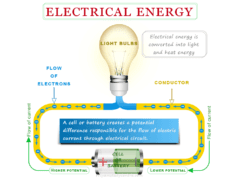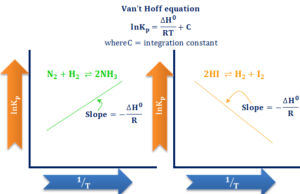Free Energy Calculation
Free energy in chemistry is a thermodynamics energy function that is used to study physical or chemical properties and calculation. The standard free energy calculation of a chemical reaction is the energy change that occurs when one mole of a molecule is formed from its constituent chemical elements at the standard state. Free energy can be described by two types of energy formulas, Helmholtz’s free energy formula or work function (A) and Gibbs free energy equation or thermodynamics potential or Gibbs function. The formation of the water molecule process spontaneously. If we mix hydrogen and oxygen at 25 °C, the hydrogen and oxygen molecule does not react appreciably due to the extremely slow rate of reaction. If the reaction rate is accelerated by an electric spark, the chemical equilibrium is established easily.

The energy actually available to do utilizable work is called free energy. Changes in the free energy (ΔG) are important for predicting the feasibility of chemical and biochemical reactions. The reactions can occur spontaneously when ΔG is negative.
Free Energy Change
The changes of ΔG, ΔH, and ΔS are expressed by the following equation,
ΔG = ΔH − TΔS
During a chemical reaction, heat may be released or absorbed. Therefore, enthalpy (ΔH) is the heat content of reactants compared to the products.
Similarly, during a chemical reaction, entropy (ΔS) represents a change in the randomness or disorders of reactants and products. Entropy attains maximum when the reaction approaches equilibrium. However, during biochemical reactions, entropy can temporarily decrease.
When ΔG is represented by a negative sign, there is a loss of energy. Therefore, the reaction is said to be exergonic and proceeds spontaneously.
On the other hand, a positive ΔG indicates that energy must be supplied to the reactants. The reaction is endergonic and cannot proceed spontaneously. When a reaction is at equilibrium, ΔG becomes zero.
Gibbs Free Energy Definition
Gibbs free energy is a thermodynamic property defined as,
G = H − TS
Where H and TS are energy terms. Therefore, G is also an energy term and is calculated from the above formula. Again, specific heat (H), kelvin temperature (T), and entropy (S) are state functions. Therefore, G is also a state function.
TS is a measure of unavailable energy for doing useful work. Therefore, G is the part of the enthalpy that is available for doing work.
Gibbs Free Energy Formula
Let us consider a reversible isothermal and isobaric change of the system,
ΔG = ΔH − TΔS
Again from thermodynamic formula, ΔH = ΔU + PΔV
∴ ΔG = ΔU + PdV − TΔS
From the 2nd of thermodynamics,
TΔS = q (heat) = ΔU + w
Here, the work may be partially mechanical and partially non-mechanical or fully mechanical or fully non-mechanical.
ΔG = ΔU + PΔV − ΔU − w
∴ ΔG = PΔV − w
From the above Gibbs free energy equation,
− ΔG = w − PΔV = wnm
Where wnm = nonmechanical work
The above formula signifies that decreases of G are equal to the non-mechanical work done by the system in the reversible isothermal isobaric process.
Gibbs Free Energy Equation
From the definition of Gibbs free energy,
G = H − TS = U + PV − TS
or, dG = dU + PdV + VdP − TdS − SdT
When the work is mechanical work only,
TdS = q = dU + PdV
Combining the above two equations,
dG = dU + PdV + VdP − dU − PdV − SdT
∴ dG = VdP − SdT
The above equation provides another basic thermodynamic Gibbs free energy formula.
Isothermal Process
For an isothermal process,
dT = 0
∴ dG = VdP
For n moles ideal gas,
V = nRT/P
∴ dG = nRTdP/P
Integrating the above energy equation,
G = nRTlnP + G0 (integration constant)
When dividing by n,
μ = μ0 + RTlnP
Where μ = G/n = free energy per mole = chemical potential
Isobaric Process
For the reversible isobaric process,
dP = 0
∴ dG = − SdT
Since the entropy of the system is always positive. Therefore, free energy decreases with increasing the temperature of the system at constant pressure. The rate of decrease of G with temperature is highest for gases and lowest for solids.
Helmholtz Free Energy Definition
Helmholtz free energy or work function is a thermodynamic property defined as,
A = U − TS
Here, U = internal energy, and TS is also an energy term. Therefore, A is also an energy term.
Further internal energy, temperature, and entropy are state functions and perfectly differential quantities. Therefore, A also a state function and perfectly differential quantity.
Helmholtz Free Energy Equation
If we consider an isothermal reversible process, the work function,
ΔA = ΔU − TΔS
Again, TΔS = q = ΔU + wmax
Therefore, the reversible isothermal process in thermodynamics yields maximum work. From the above thermodynamic formula,
ΔA = ΔU − (ΔU + wmax)
∴ ΔA = − wmax
The above formula signifies that decreases in work function are equal to the maximum work done by the system. Therefore, the work function measures the workability of a system. When the system works, A values decrease.
Work Function Formula
From the definition of thermodynamic work function,
A = U − TS
For a small change in the system,
dA = dU − TdS − SdT
When the work is mechanical,
TdS = q (heat) = dU + PdV
∴ dA = − PdV − SdT
The above equation is the basic thermodynamic work function equation.
Reversible Isothermal Process
For the reversible isothermal process,
dT = 0
Therefore, dA = − PdV
If the system contains ideal gas,
dA = − nRT/V
Integrating within the limits,
ΔA = nRT ln(V1/V2)
Therefore, with the increase of the volume of the system, work function decreases.
Isochoric Process
For the reversible isochoric system,
dV = 0
∴ dA = − SdT
Since entropy is always a positive quantity. It implies that Helmholtz’s free energy or work function A decreases with the increasing temperature of the isochoric process.








